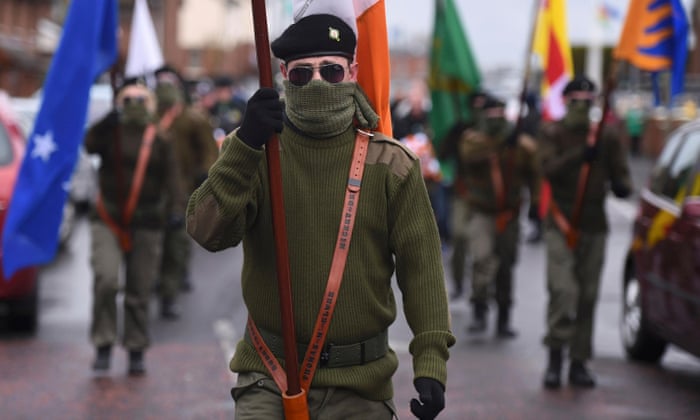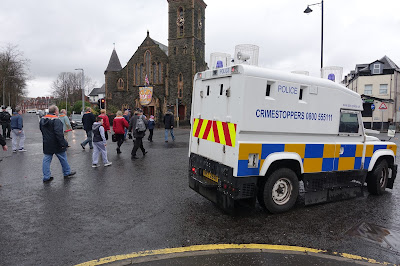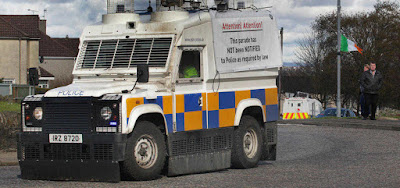On the 24th of April 1916,
Easter Monday, Dublin was thrown into disorder and chaos as around 1,200 armed
Republicans seized strategic buildings around the city. From the steps of the
General Post Office, Patrick Pearse, one of the leaders of the uprising, read a
proclamation that declared Ireland an independent republic. The revolutionaries
initially hoped that Irish Republicans all across the island would take up arms
in conjunction with the unrest in Dublin, but confusion and poor organization
meant that the Easter Rising was an affair that took place almost entirely
within Dublin. The British government reacted quickly to this unrest, and after
a week of brutal street fighting which saw hundreds of innocent people killed
in the crossfire, British rule was restored to Dublin. The leaders of the rebels
were marched through the streets as crowds booed and jeered. Tried for treason,
the leaders were shot. However, while the British might have killed these
revolutionaries, their deaths gave new life to the idea of Irish Republicanism,
and by 1919 Ireland would have its independence. The events of this short week
in 1916 continue to influence events even now, one hundred years on. In
Northern Ireland the Easter holiday lasts from Good Friday until Easter
Tuesday, over this long weekend there are celebrations throughout the Republic
of Ireland and the Catholic areas of Northern Ireland. The celebrations for the
hundredth anniversary of the rising were expected to be especially large. The
P.S.N.I also warned of possible dissident Republican attacks during the lead up
to this year’s commemorations, although none materialized.
Good
Friday
Good Friday was relatively quiet, at least
in Belfast, but in the town of Newry some hooded youths decided to try to
relive the revolution by stoning some passing P.S.N.I vehicles.
Saturday
In 2013 a group of Orangemen were stopped
by the police from marching home along their traditional route because they
would have to pass by a Catholic neighbourhood. This seemingly small act caused
huge outcry among the Loyalist community, and the Orangemen decided that they’d
not just give up and let the parade’s commission tell them when and where they
could march. Since then they have marched every night and every Saturday afternoon
to protest what they view as the attempt by the parade’s commission to infringe
on their freedom of assembly at the behest of “intolerant nationalists.” So
they march, day after day, and day after day they are greeted by a wall of
armoured cars and police officers who force them to follow the parade’s
commissions’ instructions and prevent them from reaching the Catholic area. On
Saturday I followed these Orangemen during their parade, starting at the Shankill
Road Orange Lodge and ending at the usual police barricade. The march was surprisingly
low key, the Orangemen marched silently through a Protestant neighbourhood that
seemed largely uninterested in what they were doing.
Orangemen March on the Shankill
Orangemen March on the Shankill
As we approached the
Parade’s Commissions’ ‘line in the sand’, the P.S.N.I Land Rover that had been acting
as point man for the march peeled off down a side street to our right, blocking
all movement down that way. The Orangemen kept pushing forward towards the
Crumlin Road, their ultimate goal, all that seemed to lay in front of them now
was a small hill. Our little company began their ascension, but as we neared
the summit the white roofs of the P.S.N.I Land Rovers waiting for us at the top
came into view. There were four or five armoured jeeps parked on either side of
the street, with a wall of green coated officers standing between them.
Orangemen Face the "Thin Green Line"
The
Orangemen stopped right in front of that thin green line, once again the parade’s
commission would have its way, but these marchers weren’t finished yet. One of
them pulled out a camcorder and tripod, formed their own line in front of the
police.
Orange Line
One of the Orangemen brought out a microphone, “I’ll be celebrating the
Easter Rising, the true Easter Rising, Jesus Christ is risen today alleluia … that
is the true Easter Rising” he said. After the sermon a new speaker came out
from the crowd, and had a markedly more political view of events. “We do not
gather … to cause offence, we gather to highlight the intolerance and injustice
that we face.” Claiming that the parade’s commission wants to criminalize them “simply
for walking” he stated defiantly that the “protests will continue.” As the
colours were trooped away, the Orangeman began to remove their hats, and sang
the first verse of God Save the Queen.
I’ve attached the entire speech below in case you’re interested in watching it
yourself.
Elsewhere in Ulster, unrest that would
flare up again and again over the course of the weekend began in the county
Armagh town of Lurgan. During The Troubles, Lurgan was part of “murder triangle”
an area infamous for its high number of sectarian attacks and killings. Today
Lurgan is one of the few areas in Northern Ireland where dissident Republicans
hold a significant amount of support, and that support shone bright this
weekend. On Saturday a dissident Republican colour party marched through the
Kilwilkie Estate dressed in paramilitary uniforms and hiding their faces with
masks. While they were observed by a police helicopter, the P.S.N.I did not make
any attempt to stop the parade, even though it was in violation of Northern
Irish law which maintains that all marches must be approved by the Parades Commission
before they can go ahead.

Dissident Marchers in Lurgan (Photo Credits: Clodagh Kilcoyne)
This brazen show of strength by the dissidents,
coupled with the P.S.N.I’s failure to respond outraged Unionists. News Letter reported
that the Traditional Unionist Voice’s candidate for Upper Bann stated in
response to the march: “If this had
been a Loyal Order parade the P.S.N.I would have been present in numbers to ensure
the letter of the law was observed. Yet republicans have been permitted to put
on a show of strength with masked men with no arrests.” Lurgan’s woes didn’t end as day turned into night on
Saturday, and in fact they’d only grow worse over the course of the Easter
Celebrations.
Easter Sunday
The Easter
Sunday parade on the Falls Road was probably the largest parade I’ve ever seen,
and while it might not have attracted as many spectators as the Macy’s Thanksgivings
day Parade, the turnout was still unbelievable. Ten of thousands stood under
the tricolours and green, white, and orange bunting that weaved between the lampposts
like a spider’s web. Alongside the tricolours flew the green flag of “D-Company,”
West Belfast’s local I.R.A. unit during The Troubles. Before the official
parade began, the veterans of “D-Company” marched down from Barrack Street to
the local I.R.A Garden of Remembrance on the Lower Falls (There’s a photo of
this garden on my earlier Falls Road post.) Dressed in paramilitary uniforms,
their little troop was greeted enthusiastically by the audience during their short
march.
"D-Company" Marches
"D-Company" at Attention
Once they reached the Garden, their spokesman addressed the assembled
crowd by saying: "British
rule was wrong in 1916 and it is still wrong in 2016. Let no-one tell you any
different. We will settle for nothing less than a declaration of independence." “Amhrán na bhFiann,” the national anthem of the Republic of Ireland,
and a decade of Rosary in Gaelic were then recited, to the cheers of the
assembly. All
throughout this, a P.S.N.I helicopter was keeping watch, and when someone in
the crowd threw up a drone to get a better view of the parades, a group of men
around me starting cheering that the drone was “their air force,” and that it
was going to go shoot down the helicopter!
Speakers on I.R.A Memorial
I managed to get very lucky with where I stood in
the crowd, somehow I managed to find myself in the same place that the Sinn
Fein organizers had decided to put the families of the Republicans who had been
killed during The Troubles. Each of them carried a little black and white photo
of the son, daughter, wife, husband, or whomever else they lost, it was quite
heartbreaking actually. Once “D-Company” had finished their rally, the official
parade began. Led by a colour party of men and women dressed in the uniforms of
the original Irish rebels of 1916, and carrying dummy rifles from the time,
they marched up the Falls towards the Milltown Cemetery. As the colour party
passed by the families of those who died they stopped, turned to face them, and
saluted. The families then made their way into the parade, and formed a huge party
of followers to the colour party. Once they had passed the flute bands came, at
least twenty different Republican bands marched in behind the colours, although
not all of them were Irish. I saw at least two from Scotland, two American pipe
bands from New York, and I even saw someone carrying the flag of the Basque
Nations! If you want to watch the parade, I've attached a link to what I filmed.
Families of Republicans Who Were Killed
Huge Crowds on the Falls
Huge Crowds on the Falls
Marchers in Period Clothes
 |
| Marchers in Period Clothing |
I decided to move with the parade up towards Milltown, and came face
to face with the horror of Irish weather; it felt like the conditions went from
freezing downpour to scorching sunlight every five minutes. Once the parade
finished at Milltown, the crowd shuffled into the Cemetery towards a large
stage that the organizers had assembled.
Milltown Cemetary
Milltown Cemetary
Here Gerry Adams, the leader of Sinn
Fein, gave a speech. It’s not the first time he has been at the Milltown Cemetery,
he was there when in 1988 a Loyalist named Michael Stone attacked an I.R.A
funeral with bombs and a handgun, killing three. Gerry Adams was heavily
involved in the Republican movement in the 1970s and 80s, and many of the
Protestants I talk to are adamant that he was one of the Provisional I.R.A’s
top men during The Troubles. For being an accused I.R.A man his speech was surprisingly
supportive of the Peace Process. “Huge
progress has been made in recent years. The Peace Process and the Good Friday
Agreement marked a historic shift in politics on this island. For the first
time, the roots of conflict were addressed and a democratic route to Irish
unity opened up. But there is much yet to be done” he stated, although he still
towed the classic Republican line, accusing the government of the Republic of Ireland of betraying
the revolution, and demanding the British “imperialist” government's withdrawal from
the North. I’ve attached a link to the whole speech, filmed by Sinn Fein, below (I actually filmed it
all myself but you can’t hear a thing because of the wind, so I had to find another recording.)
Back in Lurgan masked
Republicans marched again, and the “Army Council” of the Irish Republican Army
issued new threats against the security services, and warned that police
officers may be targets. The council stated that “The volunteer soldiers of the
I.R.A are ready and determined to take the war to the age-old enemy of our
nation.” In addition, an ex I.R.A man, Bernard Fox, who survived the infamous
1981 hunger strike in the Maze Prison told the media that Republicans are
entitled to use “any means necessary” to end partition. (Information Credit to
the Irish News)
Easter Monday
Tensions in Lurgan
reached a peak on Easter Monday, as a huge gathering of around 60 Loyalist
bands from all over Ulster prepared to march through the city. I actually
watched one of the bands pass by the Clifton Street interface area in North
Belfast on their way to be bussed to Lurgan. The police response was unbelievable,
with more armoured cars
than marchers being present, and officers with rifles guarding each street
corner. I've attached a link to what I filmed below.
Protestants might ask why their parades are watched so diligently by the P.S.N.I, while Republican parades always seem to have a minimal police presence, although after the events in Lurgan that morning I can understand why they might have been on their guard.
Protestants might ask why their parades are watched so diligently by the P.S.N.I, while Republican parades always seem to have a minimal police presence, although after the events in Lurgan that morning I can understand why they might have been on their guard.
Heavy Police Presence at Orange March
Heavy Police Presence at Orange March
At about 4:30 a.m. a van was hijacked and set alight
on the railroad from Belfast to Dublin that passed through Lurgan’s Republican
estates, forcing the closure of the trains for 24 hours. When police arrived at
the scene three petrol bombs were thrown at them, fortunately no injuries were
sustained. The rest of the morning was quiet, and the huge Loyalist gathering,
under heavy police guard, passed without incident. However, several hours after
the Loyalist parade passed unrest flared up again, with several masked youth’s
threw stones and petrol bombs at police Land Rovers, injuring two P.S.N.I
officers. Two fifteen year old boys were arrested in response. Youths in
Londonderry also threw petrol bombs and stones at police Land Rovers, although
there were no injuries or arrests as a result of this. (All information credit
to the Irish News)
Passive Aggressive P.S.N.I sign at Londonderry Republican Parade (Photo Credits: Irish News)

Youths Throw Petrol Bombs at P.S.N.I in Londonderry (Photo Credits: Irish News)
Until Next Time!
-Luke van Reede van Oudtshoorn
















It's really interesting how you put the Easter holiday into historical perspective.
ReplyDeleteThe speeches were quite powerful, and it definitely is not difficult to see both sides of the conflictual activity.
Were/are you ever fearful of the intense and potentially dangerous occurrences?
Stay safe, and I hope the weather eases up over there. :)
Well luckily for me I wasn't present at anywhere where violence flared, so no I wasn't too fearful. However, it is sad to see how tense relations between Catholics and Protestants still is in some parts of the country.
DeleteWow, this is a very extensive post! So, do the P.N.S.I. block the path of the parade every single day? Sounds like an exhausting time for both sides!
ReplyDeleteYes they do block the parade everyday, as well as patrol an encampment set up by the protesters on the Twaddell Avenue, I think the P.S.N.I have said that it's cost them over 18 million pounds to police this protest over the last two years.
DeleteIt's great that you got to experience all of this firsthand! In your pictures there seems to be people of all different ages at the protests..did you see a lot of kids/young people around our age, and did they come by themselves?
ReplyDeleteYes I've seen quite a few teenagers, usually in groups of friends.
Delete